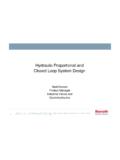Transcription of Proportional Reasoning
1 Proportional Reasoning 1 Dr Shelley Dole Dr Tony Wright School of Education Professor Doug Clarke Patrick Campus Proportional Reasoning Introduction Many topics within the school mathematics and science curriculum require knowledge and understanding of ratio and proportion. In mathematics, for example, problem solving and calculation activities in domains involving scale, probability, percent, rate, trigonometry, equivalence, measurement, the geometry of plane shapes, algebra are assisted through ratio and proportion knowledge.
2 In science, calculations for density, molarity, speed and acceleration, force, require competence in ratio and proportion. As ratio and proportion permeate so many topics in mathematics and science, the importance of study of these two concepts in the school curriculum is highlighted. In the middle years of schooling, ratio and proportion are typically studied in mathematics classes. In fact, ratio and proportion have been described as the cornerstone of middle years mathematics curriculum. However, research has consistently highlighted students difficulties with proportion and proportion-related tasks and applications, which means that many students will struggle with topics within both the middle years mathematics and science curriculum due to their lack of understanding of ratio and proportion.
3 Understanding ratio and proportion is more than merely being able to perform appropriate calculations and being able to apply rules and formulae, and manipulating numbers and symbols in proportion equations. Educators are well aware that students computational performances are not a true indicator of the degree to which they understand the concepts underlying the calculations. Understanding in mathematics is generally described as a way of knowing. Knowing ratio and proportion is about Proportional Reasoning .
4 Proportional Reasoning Before considering Proportional Reasoning , consider the meaning of the words ratio and proportion. In its barest form, ratio describes a situation in comparative terms, and proportion is when this comparison is used to describe a related situation in the same comparative terms. For example, if we say that the ratio of boys to girls in the class is 2 to 3, we are comparing the number of boys to the number of girls. When we know that there are 30 children in the class we know that, proportionally, the number of boys is 12 and the number of girls is 18.
5 We are using the base comparison to apply it to the whole situation. In order to understand this relationship Proportional Reasoning is used. Proportional thinking and Reasoning is knowing the multiplicative relationship between the base ratio and the Proportional situation to which it is applied. 2 Proportional Reasoning is being able to make comparisons between entities in multiplicative terms. This means that the relationship between the two entities is conceptualised as a multiplicative relationship.
6 For many young children, comparisons between entities are described in additive terms, and they compare groups using additive or subtractive language. For example, when comparing the number of boys to girls as in the example above (ratio of boys to girls 2:3), they may say that there is always one extra girl for each group of boys. So, if there were 4 boys, there would be five girls. Being able to describe Proportional situations using multiplicative language is an indicator of Proportional Reasoning .
7 The development of Proportional Reasoning is something that takes time. It is fostered by quality learning experiences in which students have opportunities to explore, discuss and experiment with proportion situations. Proportional Reasoning is also dependent upon sound foundations of associated topics, particularly multiplication and division. Other mathematical topics through which Proportional Reasoning grows is through the study of rational number topics including fractions, decimals, percentages, scale drawing, and of course ratio and proportion.
8 Proportional Reasoning is fostered through rich conceptual understanding of ratio and proportion, but these are difficult concepts that present a challenge to both students and their teachers. Proportional Reasoning in Science and Mathematics Mathematics and science educators are increasingly talking about Proportional Reasoning as a fundamental link between mathematics and science. As outlined above, Proportional Reasoning is required to operate in many mathematics and science topics. Proportional Reasoning is also fundamental to real-world and every-day situations, and hence underpins numeracy and scientific Reasoning .
9 For example, determining comparing 200 grams for $3 or 250 grams for $4; or understanding why a baby locked in a car on a hot day suffers more than an adult in the same circumstances, involve Proportional Reasoning . Drawing a plan view of a house, a mud map of the path from home to school, and a plan of the school yard; sharing four pizzas between three people or two chocolate bars between three people; determining the better buy when 1 kg costs $ and kg costs $ ; determining whether there is more chance of selecting red from a collection of 3 red and 4 blue compared to a collection of 6 red and 8 blue, all require Proportional Reasoning .
10 Underdeveloped Proportional Reasoning potentially impacts real-world situations, sometimes with life-threatening or disastrous consequences ( , administration of incorrect doses in medicine; inaccurate mix of chemicals in pesticides; failure to accurately convert between units of metric and imperial units of measure). A rich field of potential investigations that link science and mathematics opens up when one considers the multi-faceted and multi-dimensional nature of Proportional Reasoning . In the middle years of schooling, instruction must take an active role in supporting the development of Proportional Reasoning .







